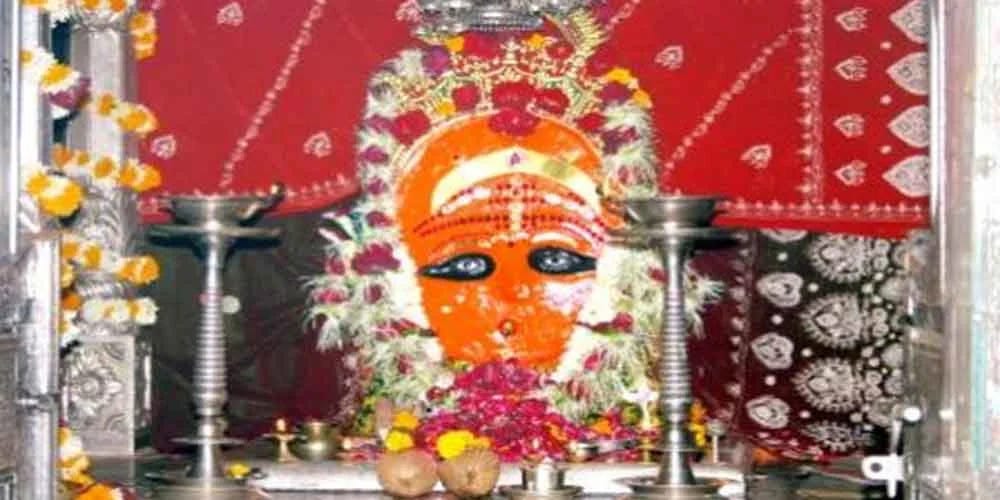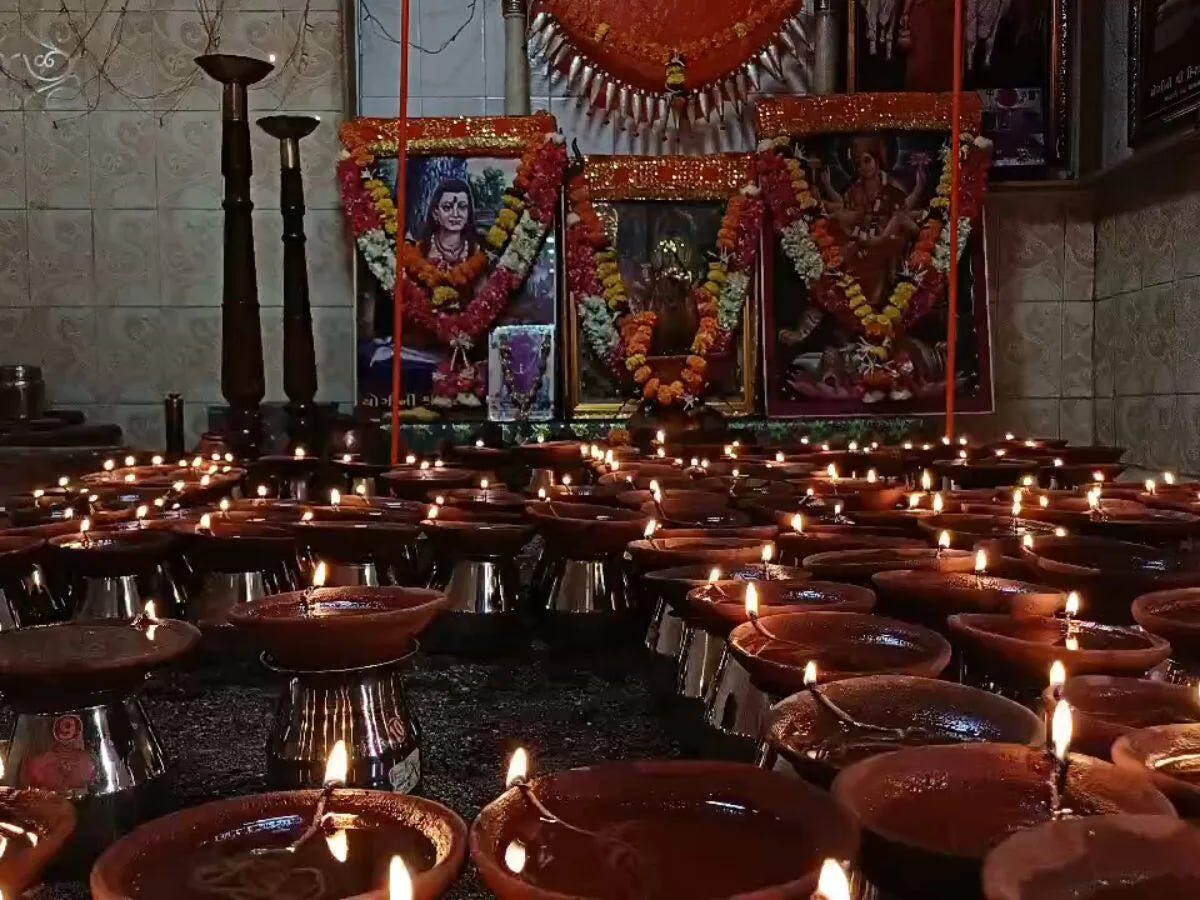Gujarat, the land of Garba, devotion, and Shakti worship, becomes a hub of spiritual fervor during Navratri. Across the state, temples echo with chants, music, and prayers, but in Junagadh, one temple draws special attention for its rare and mysterious tradition. The shrine of Hiragiri Mata, hidden within the Manganath Mahadev temple at Manganath Bazaar, opens its sanctum only during the nine days of Navratri. For the rest of the year, the doors remain closed, giving rise to legends, faith-driven curiosity, and deep reverence.
The Legend of Hiragiri Mata
Hiragiri Mata’s story is woven with spirituality and mystery.
Roots in North India: Historical accounts suggest that she was born in North India, where from childhood she displayed divine qualities - extraordinary patience, compassion, and devotion to dharma.
Life in Junagadh: She eventually settled in Manganath Pipli, Junagadh, where she lived a saintly life, spending her days in deep meditation and in service to cattle - seen as sacred companions of divinity. Her compassion toward animals and people alike earned her reverence as a living goddess.
Meeting with Manga Bhatt: Her spiritual journey took a significant turn when she encountered Pujya Manga Bhatt, a respected scholar and devotee. Recognizing her divine powers, he invited her to live at the Manganath Mahadev temple.
Jeevant Samadhi – The Eternal Rest
Hiragiri Mata believed her purpose on earth was fulfilled once her spiritual duties were complete.
She chose to take Jeevant Samadhi - a practice where enlightened souls consciously enter deep meditation and merge into the eternal.
Before her samadhi, she cut off her locks of hair and offered them to the temple as a symbol of her eternal presence.
These sacred locks remain enshrined within the temple to this day, and devotees bow before them with reverence, believing Mata’s spiritual energy still lingers there.
This event transformed the temple from just another shrine to a living testament of divine presence.
The Mystery of the Nine Days
Perhaps the most intriguing aspect of the Hiragiri Mata shrine is that it remains closed for 356 days a year, opening only during Navratri’s nine days.
Why only Navratri? Devotees believe that Navratri - dedicated to worshipping Goddess Shakti - is the time when Hiragiri Mata’s energy is at its peak.
Spiritual Reasoning: Some say the restricted access protects the sanctity of Mata’s samadhi. Others claim that the divine aura is too powerful to be approached casually, and only during Navratri is it auspicious and safe.
Cultural Belief: The mystery has only deepened the faith - devotees see the temple’s exclusivity as proof of its spiritual potency.
Rituals and Puja Traditions During Navratri
When the shrine opens during Navratri, it becomes a hub of devotion and rituals:
Pravesh Vidhi (Opening Ritual): On the first day of Navratri, priests perform special mantras, offering flowers, turmeric, kumkum, and holy water before unlocking the shrine.
Lighting the Eternal Lamp: Devotees bring oil offerings to fuel the Akhand Jyot (eternal lamp), which burns continuously throughout the nine days. This lamp is seen as Mata’s divine presence guiding devotees.
Daily Aarti: Morning and evening aartis are performed with conch shells, bells, and chanting. The atmosphere reverberates with “Jai Mata Di,” creating an aura of divine energy.
Bhajans and Garba: Devotional songs and Garba dances in Mata’s honor take place in the temple courtyard, blending spirituality with cultural expression.
Offerings (Prasad): Devotees offer coconut, jaggery, sweets, fruits, and red chunari to Mata. Special dishes like lapsi, churma, and khichdi are offered as naivedya.
Darshan of the Relics: The sacred locks of Hiragiri Mata, preserved for centuries, are displayed, and devotees bow before them seeking blessings.
The Pilgrim Experience
For devotees, visiting the shrine is not just a ritual - it’s an emotional and spiritual journey:
People from across Gujarat and India flock to Junagadh, forming long queues outside the temple.
Many walk barefoot as a mark of respect, carrying oil cans, coconuts, and flowers.
The atmosphere is charged with faith, music, incense smoke, and the glow of countless lamps, making it a once-in-a-lifetime experience.
Symbolism and Significance
The temple symbolizes the power of Shakti and the value of patience in devotion - teaching that true blessings come with faith and waiting.
The nine-day exclusivity is seen as Mata’s way of reminding devotees about the sacredness of time and the importance of discipline in worship.
For believers, Hiragiri Mata is not just a deity but a living guardian, whose energy protects Junagadh and its people.
Travel Guide – How to Visit
If you wish to experience this mystical temple, here are key details:
Location: Manganath Bazaar, Junagadh, Gujarat.
Best Time to Visit: Only during Navratri (dates vary each year based on the lunar calendar, usually September–October).
Timings During Navratri: The temple is open from early morning aarti (around 5 AM) until late-night aarti (around 10 PM).
How to Reach:
By Train: Junagadh Railway Station is well connected to major cities.
By Air: Rajkot (100 km) and Porbandar (110 km) are the nearest airports.
By Road: State buses and private taxis operate from Ahmedabad, Rajkot, and Somnath.
Local Customs: Women often offer red chunaris, while men bring oil cans for the Akhand Jyot. Photography inside the sanctum is usually prohibited.
The Hiragiri Mata Temple of Junagadh is more than just a place of worship - it is a mystery, a tradition, and a living embodiment of faith. By restricting access to just nine sacred days of Navratri, the temple preserves its sanctity, creating an aura of anticipation and reverence. For devotees, these nine days are not just about rituals but about experiencing the divine energy of Hiragiri Mata - a goddess who continues to bless her followers long after her Jeevant Samadhi.
In a world where temples are accessible every day, this shrine’s exclusivity makes it a rare jewel of Gujarat’s spiritual heritage, where mystery and devotion walk hand in hand.



